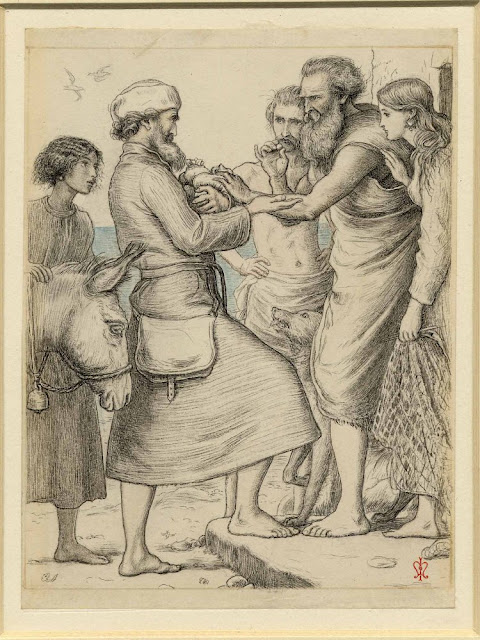 |
| Richard Parkes Bonington Sheet of figure studies, with a view of Venice 1826 drawing National Galleries of Scotland |
 |
| Richard Parkes Bonington Study of statue in Westminster Abbey (one of six sons effigied on the tomb of Lord Morris) ca. 1825 drawing National Galleries of Scotland |
 |
| John Everett Millais Married for Love 1853 drawing British Museum |
 |
| John Everett Millais Married for Rank 1853 drawing British Museum |
 |
| John Everett Millais Study for painting - Peace Concluded, or, The Return from the Crimea 1856 drawing British Museum |
The Prize
A book with poems
about Bessie Smith,
Marilyn Monroe,
Queen Elizabeth,
William Tell,
W.B. Yeats,
Ted Hughes,
Sitting Bull,
an otter, a fox, and a hare
won the Pulitzer Prize
in the first year
of the war.
In the second year,
the year of insurgency,
of bridges, corpses,
blindfolds, and dogs,
a poet who wrote
about the only species
that commits suicide
received the prize.
In the year of boycotts
and stained fingertips,
the third year of the war,
the prize went
to a retired life insurance executive
who lived on acreage
near the village of Garland,
Nebraska.
Disappearance,
from one life
to another,
was the subject
of the prizewinner
in the year of growing
sectarian violence,
the fourth of the war,
also the year of verdict
and hanging.
In the fifth year,
of surge
and black water,
the civil war continued,
and the prize
was given to a book
about our civil war,
which ended
143 years earlier.
In the sixth year,
the prize was granted
to a poet who wrote a lovely poem
about war, the war
in Europe,
where white men
killed each other
by the millions;
his poem
still mentioned an Arab,
a young man who performs
an act of purification,
removing hair
from his body,
before flying
a plane into an office building,
and that took place
fifty-eight years after the war
the poem is actually about.
The prize was shared
in the sixth year of the war,
the other book
evoking pleasures
(of family, beaches, and dogs)
and horrors
(of young men
purifying their bodies
with speed
and conviction).
In the seventh year,
the year of ceasefire
and effigy,
the prize was presented
to a book about loss,
memory,
and the continuum of time;
the book was named
after a dog
in the sky.
The war went on,
for eight years now,
and many
soldiers
(300,000)
were returned home,
and many
others
(not soldiers,
too many to count)
were returned
to the earth;
this was the year
of exit strategies,
and a book described as filled
with "little thought-bombs"
won the Pulitzer Prize.
In the year of renaming,
the ninth, a new dawn
replaced freedom,
and the prizewinner
had served
as United States Poet Laureate
in the war's sixth,
seventh, and eighth years.
The last year,
the year of withdrawal,
the prize was given to a book
named after life
on another planet,
which is a yearning
for another way to live,
which is also
another way to die.
Long after life on Earth
the depleted uranium
in the Tigris
will reach its half-life,
four and a half billion years
after the tenth year of the war,
which is
the end of time.
– Hayan Charara (published in Poetry, 2017)
 |
| John Everett Millais The Pearl of Great Price ca. 1860 drawing British Museum |
 |
| Paul Musurus Landscape with a cottage ca. 1855-65 drawing British Museum |
 |
| Paul Musurus On the edge of a lake ca. 1855-65 drawing British Museum |
 |
| Paul Musurus Trees beside a lake ca. 1855-65 drawing British Museum |
 |
| Paul Nash Box Garden, Beckley Park, Oxfordshire ca. 1940-41 photograph National Galleries of Scotland |
 |
| Paul Nash Stones at Avebury, Wiltshire 1942 photograph National Galleries of Scotland |
 |
| Walter Sickert The Hanging Gardens, Noel Street, Islington (yards at rear, seen from Regent's Canal) ca. 1925 etching British Museum |
 |
| Walter Sickert The Lion of St Mark, Venice 1915 etching British Museum |
 |
| Walter Sickert The Horses of St Mark's, Venice 1902 etching British Museum |